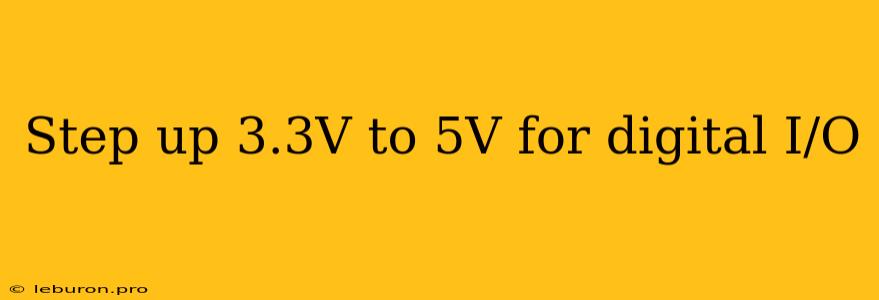In the world of electronics, interfacing devices with varying voltage requirements is a common challenge. One such scenario arises when you need to interface a 3.3V microcontroller with a device requiring a 5V logic level. This discrepancy can lead to communication issues and even damage to your components. To overcome this obstacle, a step-up converter is often employed to boost the 3.3V signal to the necessary 5V level. This article delves into the world of step-up converters and explores practical methods for stepping up 3.3V to 5V to power your digital I/O interfaces.
Understanding the Need for Step-Up Conversion
The core issue lies in the different voltage thresholds used by various electronic components. Digital circuits, like microcontrollers, use specific voltage levels to represent logical "high" and "low" states. For example, a 3.3V microcontroller may interpret anything above 2.7V as a "high" signal and anything below 0.8V as a "low" signal. On the other hand, devices designed for 5V logic might interpret anything above 3.5V as "high" and anything below 1.5V as "low."
If you directly connect a 3.3V microcontroller to a 5V device, the microcontroller's output signals might not be high enough to trigger the 5V device correctly. Conversely, if you connect a 5V device to a 3.3V microcontroller, the high voltage signal could potentially damage the microcontroller's input pins.
Step-Up Converters: The Solution
The solution to this voltage incompatibility lies in step-up converters or boost converters. These circuits are designed to increase the voltage level of a DC power source. They achieve this by storing energy in an inductor and then releasing it at a higher voltage.
Types of Step-Up Converters
There are several types of step-up converters, each with its own advantages and disadvantages:
-
Linear Regulators: These converters use a transistor to control the output voltage by dissipating excess energy as heat. They are simple to implement but inefficient, especially when operating at high current levels.
-
Switching Regulators: These converters use switches and inductors to convert energy more efficiently. They offer higher efficiency and lower heat dissipation compared to linear regulators. This type is further subdivided into:
- Boost Converters: These converters boost the input voltage to a higher output voltage.
- Buck-Boost Converters: These converters can both step up and step down the input voltage.
Choosing the Right Step-Up Converter
The choice of step-up converter depends on several factors, including:
- Input Voltage: The step-up converter should be rated for the input voltage of your 3.3V device.
- Output Voltage: You need a converter that can provide a stable 5V output.
- Output Current: The converter's output current rating should be sufficient to power the device you are connecting.
- Efficiency: Look for converters with high efficiency ratings to minimize energy loss and heat generation.
- Size and Cost: Consider the physical size and cost of the converter, especially in portable or space-constrained applications.
Practical Examples of Step-Up Converters for Digital I/O
Here are some common scenarios where step-up converters are used for stepping up 3.3V to 5V for digital I/O:
1. Interfacing a 3.3V Microcontroller with a 5V Logic Device
Imagine you are using a 3.3V microcontroller like the Arduino Uno and want to control a 5V relay. You can use a dedicated step-up converter IC like the MC34063 to generate 5V from the 3.3V supply.
2. Driving a 5V LED from a 3.3V Microcontroller
When using a 3.3V microcontroller, you can use a small step-up converter module like the LM2577 to power a 5V LED directly.
3. Connecting a 3.3V Microcontroller to a 5V LCD Display
For a 5V LCD display with a serial interface, you can utilize a dedicated step-up converter module like the MAX1771 to ensure proper communication.
Conclusion
Stepping up 3.3V to 5V is a common requirement when interfacing devices with different voltage levels. Step-up converters provide an efficient and reliable solution to bridge this gap. Choosing the right step-up converter for your application depends on factors like input voltage, output voltage, output current, efficiency, and size. With a well-selected converter, you can easily ensure smooth communication between your 3.3V microcontroller and 5V logic devices, enabling seamless operation of your electronics projects. Remember to consult datasheets for detailed specifications and proper implementation instructions.
